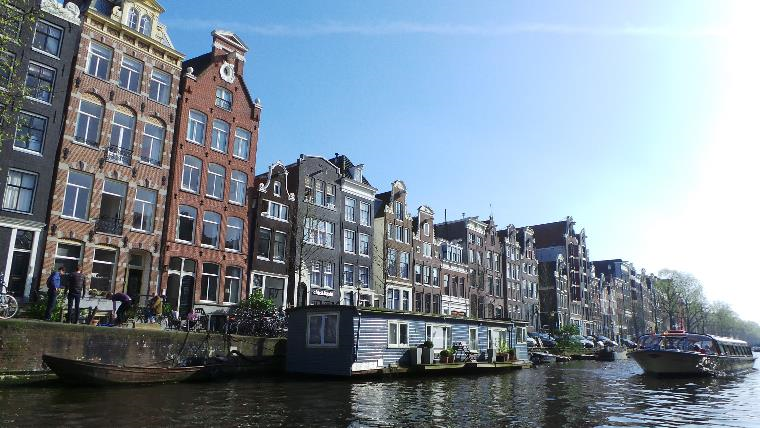 I had been warned about the cyclists in Amsterdam by an American colleague at work. I thought, don’t worry about me, I’m a European; well, from England, which is close enough. You don’t need to warn me of such things. My family and I visited Amsterdam for the first time at the beginning of April. We took a Eurostar train from St. Pancras station in London and zoomed under the Channel to Brussels, then got a connecting Thalys high-speed train to Amsterdam. The total journey, including a 45-minute stopover in Brussels, was a little under five hours. This might seem a lot compared to air travel, but we were as interested in the journey as in the destination. Our train pulled into Amsterdam Central Station at 1:42 p.m.
I had been warned about the cyclists in Amsterdam by an American colleague at work. I thought, don’t worry about me, I’m a European; well, from England, which is close enough. You don’t need to warn me of such things. My family and I visited Amsterdam for the first time at the beginning of April. We took a Eurostar train from St. Pancras station in London and zoomed under the Channel to Brussels, then got a connecting Thalys high-speed train to Amsterdam. The total journey, including a 45-minute stopover in Brussels, was a little under five hours. This might seem a lot compared to air travel, but we were as interested in the journey as in the destination. Our train pulled into Amsterdam Central Station at 1:42 p.m.
We found our way to the trams, just outside the main entrance to the strain station, and took a number 5 tram to our hotel. Fortunately, I found an ATM in the Central Station building and I was able to get some Euros for the tickets, which I bought on the tram. After checking into our hotel, The Poet Amsterdam Hotel on Jan Luykenstraat, around the corner from the Van Gogh Museum, we went for a walkabout to orient ourselves to the neighborhood. We took a leisurely stroll along the streets near the hotel and eventually found ourselves on Van Baerlestraat, then crossed a canal bridge and entered Vondelpark, a large green space where locals and visitors alike were walking and jogging in large numbers. If you wanted evidence of Amsterdam’s citizens’ love of healthy outdoor activities, this was probably as good a place as any in which to find it. We walked through the park to Stadhouderskade street, which runs next to the Singelgracht canal and the tramway that led to our hotel. After crossing the road to look at the canal we came across a ticket office for the Blue Boat Company, which operates tours of the canal system.
We had not thought much about taking a canal tour, but we were new in Amsterdam; it was only mid-afternoon and we had plenty of time with no plans for the rest of the day except to look around and take in the atmosphere. So, on the spur of the moment, a canal tour seemed like a good idea to help familiarize ourselves with the city. We purchased our tickets but then had a wait of about thirty minutes before the tour started. We decided to stroll along the path next to the Singelgracht canal to kill some time. There were some impressive mansions on the other side of the canal, which were worthy of a photograph. And then my wife spotted an Indonesian restaurant across the street from the canal and she wanted to look at the menu, so we had to cross the road again. Of course, we looked both ways before crossing Stadhouderskade and were looking straight ahead at the building in front of us when I suddenly heard an engine noise to our right, which is when I looked and saw a moped bearing down on us at some speed, which came as a big surprise because we were unaware that mopeds are allowed to use the cycle lanes as well as bicycles. My wife and daughter had either not heard or spotted the moped and so I had to grab hold of them so that they would not keep walking ahead into the path of the moped driver, who did not appear to slow down, and who only sounded his horn when he was almost on top of us, and then had to swerve to avoid hitting us. After narrowly avoiding a painful collision with the moped, and possibly the cyclists that were following closely behind, we quickly finished crossing the cycle lane to reach the pedestrian area. From our experience with this incident, as well as what we saw during the three days we were in Amsterdam, cyclists and moped drivers clearly had the right of way along the cycle lanes. After the narrow escape from the moped, a canal cruise seemed even more of a good idea. We would be able to just sit and relax and watch the city go by without having to worry about being hit by fast-moving mopeds, or bicycles for that matter.
Our stay in Amsterdam turned into a bit of a game whereby we tried to spy the next Indonesian restaurant as we walked around the streets. Just around the corner from our hotel we found Sama Sebo, on Hobbemastraat, which because it was mid-afternoon, between lunch and dinner, was only offering satay and krupuk (shrimp crackers). This was fine for us because we just wanted a quick snack and something to drink. So we had iced tea, which was made with sparkling water, and some chicken satay with peanut sauce and some of the krupuk. It was all excellent and we were especially impressed with the satay, which was made with a generous amount of chicken that was very succulent and tasty. Actually, I think it was the best satay I had ever tasted. During our stay, we also ate at the Bojo Indonesian restaurant on Leidsedwarsstraat, within walking distance of the Rijksmuseum, the huge neo-Gothic art gallery that contains Rembrandt’s “Night Watch” painting, among many others. The prices were quite reasonable at Bojo, compared to other Indonesian restaurants in the city and the quality of the food was excellent. In fact, we enjoyed the food and the atmosphere so much that we ate dinner there twice during our stay. I really enjoyed the chicken soto (soup), which had a strong flavor and the meat was very tender. The Netherlands colonized Indonesia for about 350 years, when it was known as the Dutch East Indies, and since my wife is from Indonesia we were looking forward to some good quality food from her home country. Luckily, there was plenty to choose from and we had no difficulty finding what we liked.
The Blue Boat Company operates two main tours: a 75-minute day cruise and a 90-minute evening cruise, each of which follows a slightly different route through the canal system. We took the day-time cruise, which took a leisurely circular route through the canal system by starting and finishing opposite Café Americain, close to a prominent bridge across the Singelgracht canal. Along the route we passed some of Amsterdam’s most famous sites, including the seventeenth century Westerkerk Church, with its 186-step tower; the Anne Frank House, where 13-year old Anne Frank hid with her family during the Nazi occupation in the 1940s and wrote her diary; the Tulip Museum; the NEMO science center; Rembrandt’s house; City Hall; the Hermitage Amsterdam museum; the Amstel hotel; and the Rijksmuseum. The cruise was very relaxing and was a good way to get a feel for what Amsterdam is like. Amsterdam’s most famous feature is its system of canals, and just enjoying the design of the canals, bridges and houses made it a worthwhile tour for us. The recorded commentary, which we listened to through the headphones provide by the tour company, was really just supplemental to the view from the boat. We could have enjoyed the tour without it.
During the cruise we spotted many features of the city that lived up to our expectation about what Amsterdam would be like. These included the canals themselves, of course, but also the houseboats; the canal-side cafes and restaurants; the bridges across the canals; the rows of bicycles, some of which hung from chains over the side of the canals and looked to be abandoned; the distinctive gabled houses; the pots of plants on top of houseboats that provided their owners with small gardens; the churches; and the other boats on the canals. There was no mistaking that we were in Amsterdam.
Note: During our stay in Amsterdam, we took a 5½ hour tour of the Dutch countryside. I booked the tour a couple of weeks in advance through viator.com. We got to see some Dutch cultural icons, including wooden clog making in the village of Marken, cheese making in Volendam and windmills in Zaanse Schans. The tour was provided by Lindbergh Excursions and included transportation by a comfortable double-decker bus and a multilingual tour guide, who sounded Dutch when he spoke English but was, in fact, from Spain!
More views from our visit to Amsterdam and the Dutch countryside:
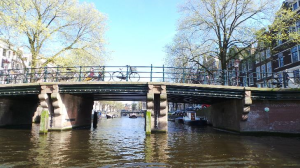
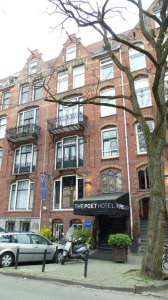

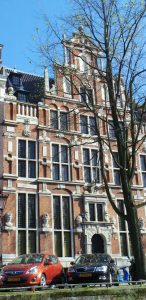
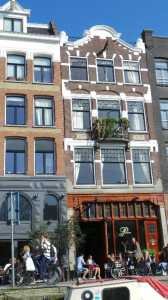
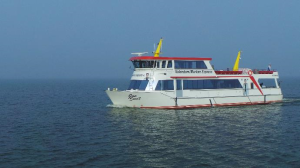
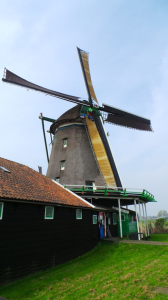

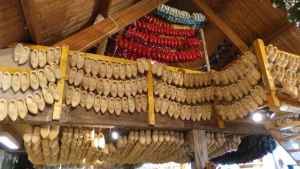
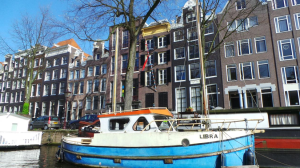
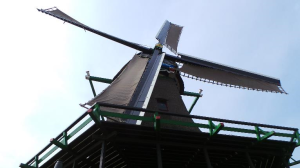
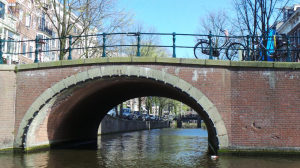
I really enjoyed this written account. It was straightforward, easy to read and because of the nature of the writer’s cultural observations I wanted to stay with the story until completion. The writer was clearly interested in surveying a place that was appropriate for a family and it led to a very pleasant read. Thank you.